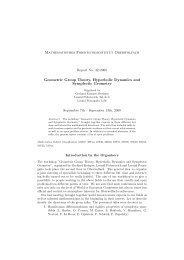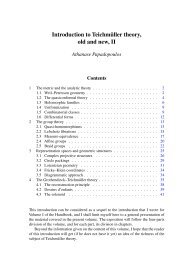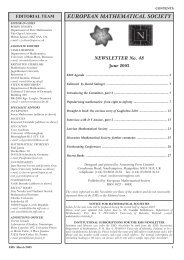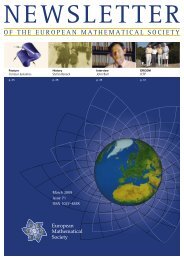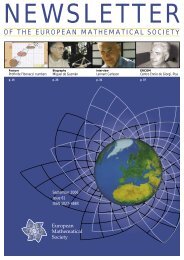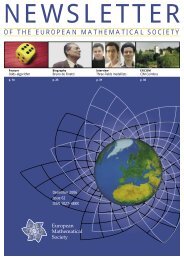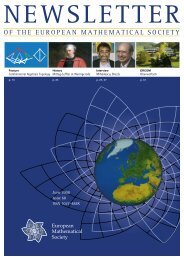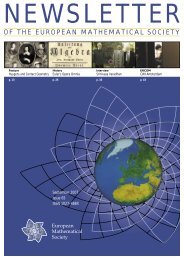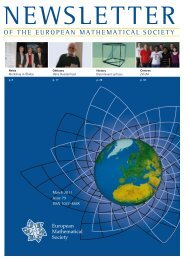EMS Newsletter June 2010 - European Mathematical Society ...
EMS Newsletter June 2010 - European Mathematical Society ...
EMS Newsletter June 2010 - European Mathematical Society ...
Create successful ePaper yourself
Turn your PDF publications into a flip-book with our unique Google optimized e-Paper software.
Zentralblatt MATHMLized<br />
Patrick Baier, Olaf Teschke<br />
1. What for?<br />
MathML 1 (<strong>Mathematical</strong> Markup Language) is an XML<br />
application to describe and display mathematical content<br />
on the Web. The current standard 2.0 was defined in 2001.<br />
With the release of the first version as a W3C recommendation<br />
as early as 1998, it may be fairly considered as a<br />
Methusalem by Web measures; but only recent versions<br />
of the most common browsers support the MathML<br />
standard.<br />
Old Zentralblatt interface: Bulky tex code.<br />
There are several reasons for this rather slow progress.<br />
Mathematics content might not have been considered<br />
to be commercially interesting by browser developers.<br />
Mathematicians were early adopters of the Web, relying<br />
on the established TeX/LaTeX formats. Enhanced display,<br />
if considered to be necessary, was usually obtained<br />
by small solutions like conversion of elements to html if<br />
possible (e.g. subscript and superscript) or the integration<br />
of small formula images; alternative formats (dvi,<br />
ps, pdf) were often provided for convenience. In general,<br />
mathematicians were quite satisfied with the language<br />
they were used to and didn’t care too much about presentation.<br />
Moreover, the conversion of the existing TeX/<br />
LaTeX corpus to MathML is non-trivial and is an ongoing<br />
challenge (probably, no one would like to create the<br />
XML directly).<br />
However, with the progress of Web mathematics<br />
– and especially its interactive components – the ad-<br />
Zentralblatt Corner<br />
vantage of a common XML standard becomes more<br />
evident. <strong>Mathematical</strong> software is widely used and it is<br />
obviously useful to have a common interface with Web<br />
presentations. Apart from the enhanced readability, automatic<br />
processing is supported. Search and retrieval of<br />
mathematics content can be enhanced significantly. As<br />
a small but important example, MathML makes mathematics<br />
content barrier-free: visually impaired users may<br />
access formulas via standard screen-readers.<br />
2. How does one convert (masses of)<br />
TeX/LaTeX?<br />
When you set up a mathematics blog today, it is usually<br />
not much effort to install MathML via available plugins.<br />
Even converting older content can be done with a<br />
reasonable effort, given that a single user won’t change<br />
New Zentralblatt interface: Direct MathML display.<br />
his (La)TeX environment too frequently. However, a<br />
digital library or mathematics database may face difficult<br />
problems in the conversion of existing content.<br />
There may be a large variety of styles and macros, even<br />
a change in TeX/LaTeX standards. Though many approaches<br />
exist for the conversion, there is no general<br />
optimal solution and one will need to check which existing<br />
tool may be the most convenient solution for a<br />
specific problem.<br />
There is limited data available for the comparison<br />
of the existing tools. H. Stamerjohans et al. (2009; Zbl<br />
1 www.w3.org/Math/<br />
<strong>EMS</strong> <strong>Newsletter</strong> <strong>June</strong> <strong>2010</strong> 55




